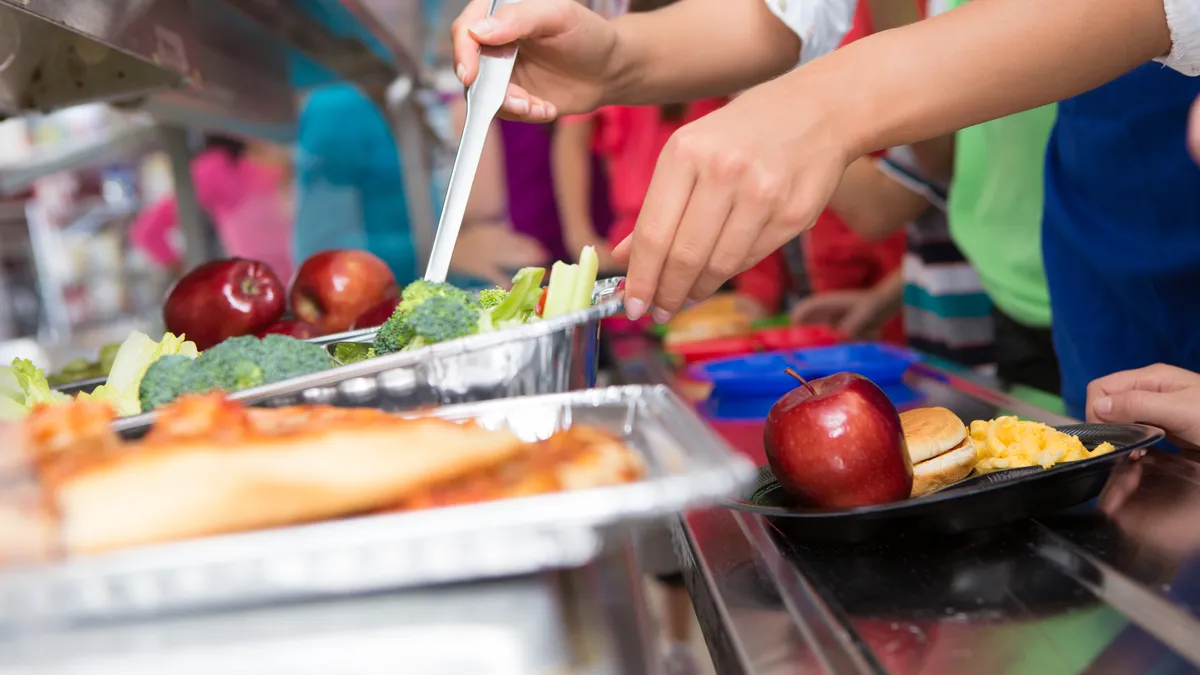Dive Brief:
- Districts are continuing to face challenges in rising costs and product shortages brought on by soaring inflation and supply chain issues, according to a new report from the School Nutrition Association, School Nutrition Foundation and Share Our Strength’s No Hungry Kid campaign.
- The U.S. Department of Agriculture on July 22 announced its annual adjustments for free and reduced-price meal reimbursement rates, adding 68 cents for each lunch and 32 cents for each breakfast. Still, schools are getting fewer federal funds per meal than they did in spring 2022 when pandemic waivers provided free meals for all.
- To address supply chain disruptions, the report found, districts are implementing creative solutions including leasing warehouse space with other districts to store bulk items. Some districts also encourage purchasing ingredients that can be used for more than one meal or recipe.
Dive Insight:
This latest report proves supply chain issues are still hurting school meal programs, but districts are at least finding strategies to better navigate these challenges, said Diane Pratt-Heavner, director of media relations at SNA.
The report authors gleaned their findings from listening sessions with 274 meal program operators, K-12 industry representatives and state agency officials.
In fall 2021, SNA released a report that found 97% of 1,368 surveyed school meal program directors said they were worried about pandemic supply chain disruptions.
While additional funding from the recently enacted Keep Kids Fed Act and the USDA is helpful in keeping schools afloat, Pratt-Heavner said the latest federal assistance still doesn’t cover as much as previous pandemic-era waivers did. For example, under the Summer Food Service Program during the 2021-22 school year, schools got $4.56 for every free lunch served. Now, they will only receive $4.43 per free lunch, Pratt-Heavner said.
The $3 billion Keep Kids Fed Act increases the federal reimbursement rates for school lunch by 40 cents and breakfast programs by 15 cents. It also continues no-cost pandemic-era waivers that help with supply chain challenges, such as relaxed nutritional standards.
The reimbursement rate is "definitely a dramatic improvement thanks to the Keep Kids Fed Act, but still a drop from what they were receiving in the spring,” Pratt-Heavner said.
Also, distributors have begun to require bigger minimum orders from schools, which has caused some districts to pivot and purchase their own warehouses for storage, the report said. Collaborating to share a lease on these spaces helps districts to split the cost.
Another solution districts discovered is bypassing supply chain problems by increasing purchases from local producers and trying to do more scratch cooking to rely less on processed items that may be hard to get, according to the report. But even those solutions have become challenging with inflation driving up costs of locally produced products and the labor shortage making it difficult to do scratch cooking, Pratt-Heavner said.
The report projects supply chain delays and product shortages will be ongoing throughout the 2022-23 school year.
As schools continue to navigate those challenges, Pratt-Heavner said, it’s crucial the reimbursement rates keep up with the increasing costs schools face to continue serving students nutritious meals.
More so, she said she is concerned additional nutrition standards may be required for schools this fall as they try to get through another year with supply chain issues.
“These programs have seen such a change in product availability and contraction in the K-12 food service industry,” Pratt-Heavner said. “We need to make sure that any standards that are proposed are realistic for schools to be able to make moving forward.”
Those concerns are to be on the table Wednesday as the House Education and Labor Committee marks up a child nutrition reauthorization bill. Introduced last week, the Healthy Meals, Healthy Kids Act aims to expand students’ access to free meals, provide school meal debt protections and give grants to help school meal program operations.













